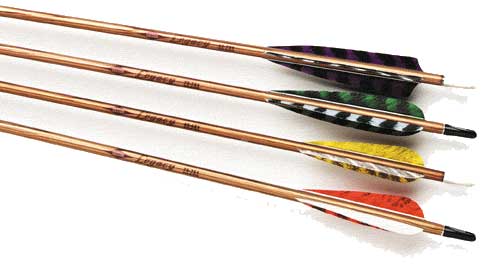Bowsite.com
The Nation's Leading Bowhunting Website
 |
By Dr. Mark Timney |
Start talking about penetration with a group of bowhunters and you’re likely to get into a friendly (or not-so-friendly) argument. But there’s really no point to such arguments. Given modern archery equipment, penetration is probably the last thing the average bowhunter needs to worry about. How deep into the ground do you really need your arrow to go after it passes through a deer?
Now, this is not to say that you should forget about the penetration potential of your setup. But it’s not anywhere near as big an issue as some make it out to be. When you consider the factors that affect penetration, and how these factors really work in the field, the whole argument about what bow/arrow/broadhead combination penetrates best is virtually moot.
The four major factors that influence penetration are Kinetic Energy, Broadhead Type, Friction, and Arrow Construction/Flight. Each work in concert, and one can sometimes influence one or more of the others and affect penetration. We’ll discuss each in turn, and then consider why we’re probably worrying for no good reason.
KE is King!
Kinetic Energy, which is commonly abbreviated as ‘KE,’ is the determining factor when it comes to penetration. The other factors play a part, certainly, but no where near to the extent that KE does. If you have enough KE, you can almost (but not quite) forget about the other factors.
KE is the ‘energy’ in the arrow as a result of its velocity and overall weight. You can calculate your shafts KE manually or with this BOWSITE calculator:
velocity x velocity x total arrow weight (in grains) divided by 450,240
|
|
How much KE do you really need? If you’re hunting deer, you don’t need much at all. As long as you make a good shot, that is. According to Easton, a 400 grain arrow traveling at the glacial speed of 170 feet-per-second has sufficient energy to harvest a mature deer. Heck, many kids bows can easily shoot such a light arrow faster than 170 fps, and I’ve seen such rigs do pass-throughs on deer!
Easton’s recommendations for KE on specific size animals are listed in the chart below. It’s very interesting to note that throughout history many large animals have been cleanly harvested with less KE than advised in the chart. This is not to say, however, that you should purposefully ‘under-power’ yourself.
|
KE |
Hunting Usage |
|
< 25 ft. lbs. |
Small Game |
|
25-41 ft. lbs. |
Medium Game (deer, antelope, etc.) |
|
42-65 ft. lbs. |
Large Game (elk, black bear, wild boar, etc.) |
|
> 65 ft. lbs. |
Toughest Game (Cape Buffalo, Grizzly, etc.) |
“What about momentum?” you ask. Momentum, like KE, is another way to measure the ‘power’ in an object that’s moving. Some have suggested that momentum is an important factor when you’re comparing the potential penetration of a heavy and slow arrow vs. a light and fast arrow. For example, a 375 grain arrow traveling at 280 fps has about the same KE as a 600 grain arrow moving at 220 fps. The latter, though, has more momentum and theoretically should provide superior penetration.
The reality, though, is something else all together. The formula for momentum is very similar to the one for KE, and the difference between the two measurements doesn’t seem to translate to the real world. Lighter weight arrows with comparatively low momentum can penetrate quite well. There are likely other variables which influence penetration far more than the minor difference between KE and momentum.
Broadhead Type
There are three aspects of this factor to consider: the number of blades on the broadhead; the broadheads overall design, particularly regarding its style of point and blade type; and, whether or not it’s a mechanical head. Friction is discussed in part here too, but will be covered in more detail later.
|
Related Bowsite Resources
|
The common belief is that a traditional style, two-blade head (think Magnus) will penetrate better than a modern, chisel tipped, 3-blade head (think Muzzy), all things otherwise being equal. This is easy to test at home. Shoot a two blade head into a foam target. Then, use the same bow/arrow combo and shoot a three-blade head. The two-blade head will probably penetrate deeper into the foam because it offers less friction. But this is foam. An animal is not made of foam.
What would likely happen in the real world if you could shoot the same animal in the same spot with these two broadheads from your hunting bow? Both arrows would pass through the deer. Perhaps the two-blade head might go deeper into the ground, but the three-blade head might offer a better bloodtrail and a quicker kill. Yes, point styles and the number of blades do affect penetration, but the differences are usually minor given the power of most of today’s bows.

What about mechanicals? Don’t they penetrate less because they waste KE in the process of opening? Do the foam test with a well designed mechanical and a standard broadhead and the mechanical will likely loose out in this type of penetration contest, But again, go into the field and I bet you won’t see much of a difference at all.
Now, there may be a more significant difference between broadheads when you hit an animal in the wrong spot. Certainly, some broadheads will outperform others when you’ve got to crunch bone. But how do you measure this or make any predictions about penetration from it? You can’t! Every bad hit is a little different, and each broadhead performs a little differently depending upon the circumstances.
For example, I once killed a deer with a mechanical on a low hit that would have resulted in a flesh wound had I been using a regular head. Then, I’ve had the unfortunate experience of having a mechanical wound a deer when I’m convinced a regular head would have put it down quickly. In the end, if you choose a good quality head, regardless of the type, penetration won’t be a problem.
One thing about blade design, though, especially with mechanicals: Always go for blades that are placed at an angle so that they ‘cut’ rather than ‘wedge’ their way through an animal. I’m convinced that much of the reported penetration problems with some mechanicals is the result of KE lost to ‘wedging’ rather than KE lost to opening the blades.
Also, remember that an arrow kills by causing massive hemorrhaging. A dull blade, or one with serrations, won’t cause the same degree of bleeding as a plain, ultra-sharp blade will. In fact, dull or serrated blades could reduce penetration more than most of the other factors we’re discussing here.
Friction
Friction is sometimes considered an important factor in penetration when it comes to broadhead styles and arrow shaft diameter. But, once again, it doesn’t seem to matter in the real world.
From a theoretical standpoint, a smooth, small diameter broadhead and arrow should penetrate deeper than a rough, fat headed, large diameter shaft. It certainly works that way if you do the foam test. But we’re talking about slicing through hide, muscle, bone, and organ tissue.... stuff that’s fairly lubricated with blood and other bodily fluids. There are so many other variables here that it’s likely friction has very little to do with penetration in a typical kill.

Arrow Construction
You may have heard that carbon shafts penetrate deeper than aluminum shafts. This is because carbon shafts are typically lighter than equivalently spined aluminum shafts (superior stiffness/weight ratio) and are better at dampening vibration. Thus, they flex less and recover from flex faster at impact. This means they waste less KE and have more power available for cutting. (NOTE: This could be a factor that cancels differences in momentum.)
Again, though, what happens in the lab doesn’t seem to make a substantial difference in the field. The differences between the shaft materials/weight aren’t such that it shows given the excess KE that most bows generate.
Poor arrow flight, however, is probably more noticeable, but maybe not any more potentially damaging to penetration. An arrow shot from an out-of-tune rig will dissipate energy as ‘wags its tail’ attempting to correct its flight. Excess arrow correction sucks up velocity, which results in lower KE. But the loss of velocity is minimal at typical bowhunting ranges.
Perhaps a more significant problem with poor arrow flight, though, relates to a ‘wagging’ arrow hitting the animal. If the arrow hits a little sideways, the force of the impact isn’t square to the point of the broadhead. This too will waste KE. How this effects penetration depends upon the situation. Only the most out-of-tune bows, however, cause arrows to continue correcting much beyond ten yards.
History, Marketing, and Bowhunting
Much of our worry about penetration is probably left over from the days when most bowhunters were shooting traditional gear. Indeed, there was, and still is, more cause to think about penetration if you’re shooting traditional equipment. But today’s compounds are incredibly powerful in comparison. There’s plenty of KE to spare. And that’s the bottom line here.
If you’re not so sure of that, consider how well traditional tackle does on game without the benefit of extra KE. Many traditional shooters consistently achieve pass-throughs on deer. Some even do it with obsidian heads and home-made wooden arrows!
I also believe we’ve been ‘hyped to death’ by some manufacturers about how to improve penetration. Their advertising has made it sound like there was a problem to be solved. But, for the most part, there isn’t.
If you do hear a bowhunter talk of a penetration problem, it’s probably because the arrow didn’t go where it was supposed to. He either blew the shot, or took a risky one. And that’s what really bothers me about this whole penetration thing. Put the arrow where it counts and penetration isn’t going to be a factor. Put the arrow into a shoulder, and you’ve probably got trouble regardless of your setup.
Yes, it makes sense to have extra ‘power’ for larger game and for those times when an ethical shot results in a less than perfect hit. But spend your time learning where to shoot an animal and how to shoot well, rather than seek the Holy Grail of penetration. You’ll be far better off in the long run.



